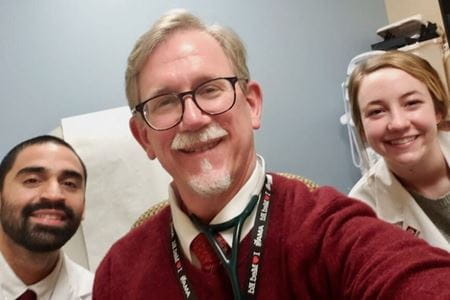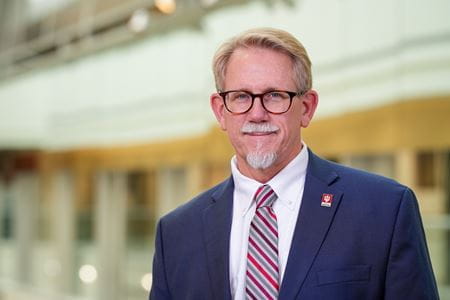When Bradley Allen was 11, he was riding his bike home at dusk after ice skating with friends on a frozen creek in northwest Iowa farm country, when he was struck by a car. He suffered head injuries and a major leg fracture that landed him in the hospital, and his leg in traction, for a month — through the Christmas holiday. That extended stay was his first glimpse into the medical profession and the importance of skilled, compassionate care.
Today he often rides his bike — with helmet and safety lights — near his Zionsville, Indiana home, along rural roads which remind him of the corn and soybean fields of his family farm. Occasionally, he cycles nearly 20 miles to downtown Indianapolis to the Indiana University School of Medicine, where Allen, MD, PhD, was recently named executive associate dean for educational affairs after serving as interim leader since fall of 2024.
It's been a long journey from first-generation college student to becoming one of the top leaders at the nation’s largest medical school.
“Dr. Allen brings a distinguished record of academic leadership, clinical expertise in infectious diseases, and a deep commitment to educational excellence,” said IU School of Medicine Dean Jay L. Hess, MD, PhD, MHSA, in an announcement to the school community. “His ability to connect vision with action, paired with a collaborative approach, will continue to strengthen our mission of preparing the next generation of physicians and health care leaders.”
Allen takes on this executive role at a time of transition for the medical school. Hess recently announced he will step down as dean in July 2026 after more than a dozen years of leading transformative growth which saw the medical school class size increase by 30%. Allen, who has been at IU since 2000 and was formerly senior associate dean for medical student education, will ensure consistency in carrying the school’s educational mission forward.
“Dean Hess helped us realize how much talent we have across the state and how we can harness that effectively to answer important research questions, run more clinical trials statewide, and build a healthier state — to give our patients and our trainees access to what cutting-edge medicine looks like,” said Allen, the Dolores and John Read Professor of Medical Education and a professor of clinical medicine who was recently elected to mastership in the American College of Physicians. “He really embraced the idea of ‘one school, nine campuses’.”
Listening and leading
Allen enjoys a view of the rising IU Health hospital from his new office in the recently opened Medical Education and Research Building — filled with collaborative spaces and the latest technologies for training medical students, along with student services. It allows him to mingle with the student body he has long served.
 The bespectacled leader is a familiar face to all. He grins wide and often sings. But most importantly, he listens, said fourth-year student Matthew Gregory, who was paired with Allen as his physician mentor when he first entered medical school. During a dinner with mentees, Gregory remembers Allen munching away on olives while others did the talking.
The bespectacled leader is a familiar face to all. He grins wide and often sings. But most importantly, he listens, said fourth-year student Matthew Gregory, who was paired with Allen as his physician mentor when he first entered medical school. During a dinner with mentees, Gregory remembers Allen munching away on olives while others did the talking.
“After allowing his mentees to speak freely and without interruption, and with an impressive debris field of olive pits now in front of him, he responded thoughtfully to each of us, making it clear that he had been listening intently the whole time,” Gregory recalled. “From Dr. Allen, I learned the twinned arts of facilitating a conversation and listening.”
Allen majored in microbiology at the University of Iowa, then applied to the school’s medical scientist program. Later, as chief resident in internal medicine at Baylor College of Medicine, Allen discovered how much he enjoyed teaching, while continuing to be involved with infectious disease research.
He recalls seeing his first HIV patient as a medical resident in 1987. At the time, it was seen as a death sentence.
“Medicine has come so far,” Allen said. “Now we are able to offer drugs that really change and prolong people’s lives with a virtually normal life expectancy and the ability to treat HIV as a chronic disease and not a terminal diagnosis.”
Allen joined the faculty at IU School of Medicine in 2000, intent on doing research. “Keep an open mind,” he now tells students. His career has taken several turns from faculty researcher to chief of medicine at the Richard L. Roudebush VA Medical Center to clinical administration roles at IU within medical education.
Even with his current duties in educational affairs, Allen still sees patients at the VA hospital every Tuesday. He sometimes has learners alongside him. One was Alexa Petrucciani, a student in the Medical Scientist Training Program. She later asked Allen to formally join her dissertation committee for her PhD project focused on tuberculosis.
“I was extremely lucky that he was such an outstanding mentor who also happened to have expertise in my area of study,” she said. “During my graduate years, he made it possible for me to shadow him in clinic — no small feat given the VA’s strict policies. He was consistently available for guidance, serving as a sounding board for career decisions and fellowship applications. He also actively looks for opportunities to support his mentees.”
During his time leading medical student education, Allen helped launch a standardized statewide curriculum and was instrumental in the school’s reaccreditation efforts by the Liaison Committee on Medical Education (LCME) in 2017 and 2025.
“The progress we’ve made in education has been dramatic,” he said. “Our students’ satisfaction with their training has gone up, as has their performance, staying above the national average on standardized exams and getting higher and higher match rates into their top choices for residency training, including those in primary care and the most competitive fields.”

Training Indiana’s primary care physicians
Match Day is one of Allen’s favorite annual events. It’s a time to celebrate the payoff for medical students’ perseverance and hard work as they match into medical specialty programs. Especially rewarding is “knowing that many of them faced significant challenges and doubts along their journey — and that the school might have, through our student support services, helped them achieve their goals and become confident and accomplished healers as they graduate and move into the direct care of patients.”
“I think IU is viewed by most programs across the United States as having really well-trained students who are prepared for that next phase of training,” added Allen.
In recent years, IU has expanded graduate medical education with the opening of several new residency programs in internal medicine, family medicine, emergency medicine and psychiatry throughout the state, in partnership with IU Health and other regional health systems.
Allen’s work on two major grants from the Health Resources and Services Administration (HRSA) directly supports the development of new primary care doctors to work in Indiana communities that are medically underserved. Those areas include many rural communities similar to Aurelia, Iowa, population 968, where Allen’s family raised turkeys and cattle and grew corn and soybeans on 2,500 acres outside of town.
“I realized how tough it is to be a provider in a community that doesn’t have a lot of resources,” Allen said.
In Indiana, 75% of the 92 counties are designated as primary care health professional shortage areas. The Indiana Primary Care Advancement in Clinical Training (INPACT) program, which Allen leads, aims to recruit more medical students from underserved parts of the state and train them to return to those communities as primary care doctors.
 “His creativity and commitment to developing primary care physicians for our state has led to significant grant funding success that has opened up new opportunities for training and scholarships for our students across the state,” said Emily Walvoord, MD, interim senior associate dean for medical student education and the associate dean for student affairs.
“His creativity and commitment to developing primary care physicians for our state has led to significant grant funding success that has opened up new opportunities for training and scholarships for our students across the state,” said Emily Walvoord, MD, interim senior associate dean for medical student education and the associate dean for student affairs.
The HRSA grant also supports enhanced curriculum that includes health systems science and builds awareness about potential barriers many people face in accessing quality health care.
“We’ve seen a bit of an uptick in the proportion of our students who are going into primary care,” Allen said. “And even if they don’t go into primary care, I think they have a better understanding of opportunities that exist for building healthier communities.”
Jennifer Schwartz, MD, calls Allen “the ideal leader.” As the associate dean of continuing education for healthcare professions, Schwartz appreciates the supportive environment Allen creates for both learners and the educational affairs team.
“He ensured that our curricular team was given space to best integrate these new concepts and ideas, capitalizing on our in-depth knowledge of our complex, multi-campus system,” she said. “It doesn’t hurt that he has a fantastic sense of humor that allows us to have fun as a group while we work hard for our learners. Dr. Allen is incredibly knowledgeable, approachable and supportive, and I am thrilled that he has taken on this role. I look forward to what we can accomplish together.”

